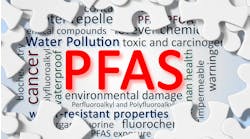THIS MONTH’S PUZZLER We’re in the midst of investigating a fatal accident caused by a fire that occurred at a petrochemical storage facility. A farmer living nearby reportedly smelled gasoline for several days before the accident. He says he called the refinery several times but wasn’t taken seriously. The Fluid Catalytic Unit (FCU) that produces much of the refinery gasoline was having an emergency turnaround during this period, so staff were stretched thin. They didn’t see much urgency because of the tank farm’s safety system, which relies on redundant controls with an automatic gauging system and high/high alarms on each tank. Finally, two operators drove out to the tank farm and died in the fire. How should we approach this investigation? Do you have any suggestions for improvements in the tank farm? What do you think killed the two operators? PUT IN LEL DETECTORSInstall LEL [lower explosive limit] detectors for organic vapors throughout the tank farm. These detectors would have allowed the operators to know of the condition of the atmosphere before entering the area. They also help detect leaks from valves, flanges and other equipment, besides tank overflows. If the tank farm operators had been informed of the farmer’s concerns, they should have walked into the area, not driven. (So, perhaps the response procedures are not what they should have been or the dead operators ignored them.) Ron Dettmann, chemical environmental engineer
SABIC Innovative Plastics, Ottawa, Ill. CONSIDER STATIC ELECTRICITYIn my view, the problem is not in the tank level but in the obnoxious vapor control vent system. A flammable gasoline concentration sufficient to ignite accumulated somewhere. It was set off from an ignition source, possibly from the vehicle that the operators who died were in or from static electricity. (One possible cause could be a stone thrown by the vehicle.) I suggest alarm ground monitor stations for hydrocarbons and activated carbon systems on the tank vents to capture fumes. As for how to approach the investigation, I would look into the plant’s failure to respond to the farmer’s complaint, possible fuel spills in the area or tank leakage, weather conditions at the time of the incident, motivation to check the tank farm and the possible connection to the turnaround. I also would look at improvements to the plant emergency response program. Next, I would inspect the operator training records and review their procedures for handling flammable or explosive chemicals. Robert Drucker, consultant
Northport, Ky.THINK LIKE A LAWYERIf BP’s experience at Texas City teaches us anything it’s that there’s no win-win scenario. Once the Chemical Safety Board (CSB) finished their study it was clear that BP’s problems were systemic. I was working at the BP refinery in Whiting, Ind., while the Occupational Safety and Health Administration (OSHA) was settling on the fines for compliance errors found there — it was something more than $400,000. They’re on a long road to recovery. Your only successful approach with accidents is to show good progress on resolving problems. Ideally, you should identify these problems, not wait for the CSB or OSHA. Don’t underestimate them! Do so at your own risk. Try approaching the accident the way a lawyer would: run offense and defense. Define your strengths and weaknesses. Find out what the farmer knows, how often he has complained, and what his experience level is. If he has experience working at the refinery you could be in real trouble. Review the records. How does the refinery respond to these complaints and leaks in the tank farm? If it has a history of ignoring complaints OSHA will see that you pay. While the accident is fresh, within the first day, draw a preliminary timeline for it. Plant politics can be a minefield, so be careful to sidestep anyone who won’t cooperate. Show people the hard evidence. Don’t be afraid to mention that you’re trying to head off or minimize an OSHA fine. Remind them, subtly, that their jobs are on the line. Talk to all shifts. Speak to contractors who worked at the FCU and the tank farm, even if they weren’t working the day of the accident or even involved in the turnaround. You may pick up some scuttlebutt that leads your investigation to some useful conclusions. The timeline will be the basis for your root cause analysis (RCA). Before drawing it, develop a spreadsheet with all the relevant facts: who, what and when as well as supporting information. Having people recount what and when they did something isn’t enough — you’ll need proof. What do other shifts say? Distributed control system logs will show when equipment was started and stopped. Make sure you secure records on paper immediately after the accident. It’s probably a good idea to augment your spreadsheet with a “gotcha” table. This sheet will list items that OSHA will question or fine you on ― keep it honest but remember it’s part of the record. Look into past fines if you’re not sure what causes trouble. Next, check the background information. Are your drawings, especially your process and instrumentation drawings, current and accurate? If they’re not, OSHA will fine you. Inaccurate drawings should be in your gotcha file. With boxes of information collected, it’s time to put it all together. Now, you’ll start beefing up the RCA tree. Because of the critical nature of this type of study you’ll want to keep track of your questions and other questions from the gotcha table. If possible, review the questions for clarity with others, especially non-engineers. After a few drafts, you’ll have a useful document. As for how the operators died, I would avoid speculation. However, this accident sounds similar to how the fire started in Texas City in March 2005. It may be that the truck exhaust started the fire. Or, it may be that a loose stone sparked the fire; tank farms normally are filled with gravel rather than paved. This situation involving vehicles has happened before and OSHA and CSB have warned against it. Gee, maybe this is a gotcha? Operators now are taught to shift to park and run if they can’t turn off the truck ignition. That’s probably what saved the operators at Texas City. Clearly they were properly trained. Chances are that there won’t be definitive evidence of what killed the operators, so don’t waste time on it. You’ve got to prepare for the onslaught of reporters, company lawyers and other non-technical people who want to get the scoop on the accident. Now, as for improvements, take careful stock of calibration records for alarms and level measurements in the tank farm. Review these with operators and managers separately; some safety measures don’t work the way they should. At this point, you’ll want to make a decision based on what you find out: take the offensive because you installed a perfectly good, well-maintained system that failed for some unexpected reason, or go on the defensive and promise to make amends. Make sure recommended improvements are thoroughly defined. As always, keep good records, avoid jargon, and prepare a report almost anyone can understand. You don’t want your career to become another casualty of the accident. Dirk Willard, senior process engineer
Swenson Technologies, Monee, Ill. SEPTEMBER’S PUZZLERWe feed grain via a screw conveyor from a silo to a mill. After grinding the material is conveyed by a pressurized pneumatic conveyor up six stories to cereal cookers. The pneumatic lines are bare pipe and run indoors. The mill room has fans but the air is humid in central Ohio in the summertime. Eventually, cereal is rolled into breakfast flakes. Unfortunately, the cereal often takes on a musty smell, which is worse in the winter. The cookers sometimes fail bacteria screening — the contamination has been traced back to the mill. Operators have seen water dripping from the conveyor ducts, although the moisture levels in the silo are only in the 8%–9% range. What’s the source of the mysterious water and how can we eliminate or reduce the odor problem? How would you approach this problem? Send us your comments, suggestions or solutions for this question by September 12, 2009. We’ll include as many of them as possible in the October 2009 issue and all on ChemicalProcessing.com. Send visuals — a sketch is fine. E-mail us at mailto:[email protected] or mail to Process Puzzler, Chemical Processing, 555 W. Pierce Road, Suite 301, Itasca, IL 60143. Fax: (630) 467-1120. Please include your name, title, location and company affiliation in the response. And, of course, if you have a process problem you’d like to pose to our readers, send it along and we’ll be pleased to consider it for publication.
SABIC Innovative Plastics, Ottawa, Ill. CONSIDER STATIC ELECTRICITYIn my view, the problem is not in the tank level but in the obnoxious vapor control vent system. A flammable gasoline concentration sufficient to ignite accumulated somewhere. It was set off from an ignition source, possibly from the vehicle that the operators who died were in or from static electricity. (One possible cause could be a stone thrown by the vehicle.) I suggest alarm ground monitor stations for hydrocarbons and activated carbon systems on the tank vents to capture fumes. As for how to approach the investigation, I would look into the plant’s failure to respond to the farmer’s complaint, possible fuel spills in the area or tank leakage, weather conditions at the time of the incident, motivation to check the tank farm and the possible connection to the turnaround. I also would look at improvements to the plant emergency response program. Next, I would inspect the operator training records and review their procedures for handling flammable or explosive chemicals. Robert Drucker, consultant
Northport, Ky.THINK LIKE A LAWYERIf BP’s experience at Texas City teaches us anything it’s that there’s no win-win scenario. Once the Chemical Safety Board (CSB) finished their study it was clear that BP’s problems were systemic. I was working at the BP refinery in Whiting, Ind., while the Occupational Safety and Health Administration (OSHA) was settling on the fines for compliance errors found there — it was something more than $400,000. They’re on a long road to recovery. Your only successful approach with accidents is to show good progress on resolving problems. Ideally, you should identify these problems, not wait for the CSB or OSHA. Don’t underestimate them! Do so at your own risk. Try approaching the accident the way a lawyer would: run offense and defense. Define your strengths and weaknesses. Find out what the farmer knows, how often he has complained, and what his experience level is. If he has experience working at the refinery you could be in real trouble. Review the records. How does the refinery respond to these complaints and leaks in the tank farm? If it has a history of ignoring complaints OSHA will see that you pay. While the accident is fresh, within the first day, draw a preliminary timeline for it. Plant politics can be a minefield, so be careful to sidestep anyone who won’t cooperate. Show people the hard evidence. Don’t be afraid to mention that you’re trying to head off or minimize an OSHA fine. Remind them, subtly, that their jobs are on the line. Talk to all shifts. Speak to contractors who worked at the FCU and the tank farm, even if they weren’t working the day of the accident or even involved in the turnaround. You may pick up some scuttlebutt that leads your investigation to some useful conclusions. The timeline will be the basis for your root cause analysis (RCA). Before drawing it, develop a spreadsheet with all the relevant facts: who, what and when as well as supporting information. Having people recount what and when they did something isn’t enough — you’ll need proof. What do other shifts say? Distributed control system logs will show when equipment was started and stopped. Make sure you secure records on paper immediately after the accident. It’s probably a good idea to augment your spreadsheet with a “gotcha” table. This sheet will list items that OSHA will question or fine you on ― keep it honest but remember it’s part of the record. Look into past fines if you’re not sure what causes trouble. Next, check the background information. Are your drawings, especially your process and instrumentation drawings, current and accurate? If they’re not, OSHA will fine you. Inaccurate drawings should be in your gotcha file. With boxes of information collected, it’s time to put it all together. Now, you’ll start beefing up the RCA tree. Because of the critical nature of this type of study you’ll want to keep track of your questions and other questions from the gotcha table. If possible, review the questions for clarity with others, especially non-engineers. After a few drafts, you’ll have a useful document. As for how the operators died, I would avoid speculation. However, this accident sounds similar to how the fire started in Texas City in March 2005. It may be that the truck exhaust started the fire. Or, it may be that a loose stone sparked the fire; tank farms normally are filled with gravel rather than paved. This situation involving vehicles has happened before and OSHA and CSB have warned against it. Gee, maybe this is a gotcha? Operators now are taught to shift to park and run if they can’t turn off the truck ignition. That’s probably what saved the operators at Texas City. Clearly they were properly trained. Chances are that there won’t be definitive evidence of what killed the operators, so don’t waste time on it. You’ve got to prepare for the onslaught of reporters, company lawyers and other non-technical people who want to get the scoop on the accident. Now, as for improvements, take careful stock of calibration records for alarms and level measurements in the tank farm. Review these with operators and managers separately; some safety measures don’t work the way they should. At this point, you’ll want to make a decision based on what you find out: take the offensive because you installed a perfectly good, well-maintained system that failed for some unexpected reason, or go on the defensive and promise to make amends. Make sure recommended improvements are thoroughly defined. As always, keep good records, avoid jargon, and prepare a report almost anyone can understand. You don’t want your career to become another casualty of the accident. Dirk Willard, senior process engineer
Swenson Technologies, Monee, Ill. SEPTEMBER’S PUZZLERWe feed grain via a screw conveyor from a silo to a mill. After grinding the material is conveyed by a pressurized pneumatic conveyor up six stories to cereal cookers. The pneumatic lines are bare pipe and run indoors. The mill room has fans but the air is humid in central Ohio in the summertime. Eventually, cereal is rolled into breakfast flakes. Unfortunately, the cereal often takes on a musty smell, which is worse in the winter. The cookers sometimes fail bacteria screening — the contamination has been traced back to the mill. Operators have seen water dripping from the conveyor ducts, although the moisture levels in the silo are only in the 8%–9% range. What’s the source of the mysterious water and how can we eliminate or reduce the odor problem? How would you approach this problem? Send us your comments, suggestions or solutions for this question by September 12, 2009. We’ll include as many of them as possible in the October 2009 issue and all on ChemicalProcessing.com. Send visuals — a sketch is fine. E-mail us at mailto:[email protected] or mail to Process Puzzler, Chemical Processing, 555 W. Pierce Road, Suite 301, Itasca, IL 60143. Fax: (630) 467-1120. Please include your name, title, location and company affiliation in the response. And, of course, if you have a process problem you’d like to pose to our readers, send it along and we’ll be pleased to consider it for publication.
Latest from Water/Wastewater
Latest from Water/Wastewater


